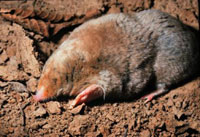Prevention and Control
 The mole seems to possess a natural shrewdness and ability to sense danger and can be somewhat challenging to trap.
The mole seems to possess a natural shrewdness and ability to sense danger and can be somewhat challenging to trap.
Cultural Methods and Habitat Modification
In practice, packing the soil with a roller or reducing soil moisture may tend to reduce the desirability of the habitat to moles. Because moles feed largely on insects and worms, the use of certain insecticides to control these organisms may reduce the food supply of moles, causing them to leave the area. However, before leaving the area the moles may increase their digging in search of food, thereby possibly increasing damage to turf or garden areas.
Repellents
The repellent Thiram is federally registered for protecting bulbs from mole damage.
Mothballs or moth flakes occasionally are suggested as mole repellents. When placed into the moles' runways, they are reputed to cause the mole to leave. There is little information to substantiate their effectiveness.
Toxicants
There are a number of difficulties in poisoning moles. Since moles normally do not consume grain, poison grain baits are seldom effective. One poison is federally registered for use against moles. The toxicant is zinc phosphide. Ready-to-use grain baits containing this ingredient are often sold at nurseries or garden supply stores.
Fumigants
Fumigants are also federally registered for use against moles. They are aluminum phosphide, calcium cyanide, and gas cartridges.
Most of these are Restricted Use Pesticides. These fumigants would have the greatest effectiveness if the material were placed in the deep burrows of the mole, not the surface runways. However, golf course owners report moles can be repelled from surface tunnels. Since state pesticide registrations vary, check with your local Extension Service office for information on toxicants and repellents legal in your area. Care should be taken when using chemicals and the label instructions should be read, understood, and followed.